Numerical Simulation and Design of a High-Temperature, High-Pressure Fluid Transport Pipe
Abstract
:1. Introduction
2. Methodology and Implementation
2.1. Problem Description
2.2. Theoretical Approach
2.2.1. Heat Transfer and Structure Analysis
2.2.2. Gas Leakage
2.3. Numerical Method
2.3.1. Simulation of Heat Transfer, Thermal Stress, and Mechanical Stress
2.3.2. Gas-Leak Simulation
3. Results and Discussion
3.1. Simulation of Heat Transfer, Thermal Stress, and Mechanical Stress
3.2. Gas-Leak Simulation
4. Conclusions
Author Contributions
Funding
Acknowledgments
Conflicts of Interest
References
- Chung, D.Y.; Shin, N.; Oh, M.; Yoo, S.H.; Nam, S.H. Prediction of erosion from heat transfer measurement of 40 mm gun tubes. Wear 2007, 263, 246–250. [Google Scholar] [CrossRef]
- Suyadnya, K.A.; Tarwidi, D.; Umbara, R.F. Numerical modeling of heat transfer in gun barrel with experimental validation. Int. J. Eng. Technol. 2019, 8, 62–66. [Google Scholar]
- Degirmenci, E.; Dirikolu, M.H. A thermochemical approach for the determination of convection heat transfer coefficient in a gun barrel. Appl. Therm. Eng. 2012, 37, 275–279. [Google Scholar] [CrossRef]
- Abhilash, P.; Chopade, M.R. Analysis of heat transfer coefficient inside gun barrel. Int. J. Curr. Eng. Technol. 2016, 5, 460–463. [Google Scholar]
- Mishra, A.; Hameed, A.; Lawton, A. A novel scheme for computing gun barrel temperature history and its experimental validation. J. Pressure Vessel Technol. 2010, 132, 1–6. [Google Scholar] [CrossRef]
- Noh, J.H.; Kwak, D.B.; Kim, K.B.; Cha, K.U.; Yook, S.J. Inverse heat conduction modeling to predict heat flux in a hollow cylindrical tube having irregular cross-section. Appl. Therm. Eng. 2018, 128, 1310–1321. [Google Scholar] [CrossRef]
- Babaei, H.; Malakzadeh, H.; Asgari, H. Stress analysis of gun barrel subjected to dynamic pressure. Int. J. Mech. Eng. Appl. 2015, 3, 71–80. [Google Scholar] [CrossRef]
- Yu, Q.; Yang, G. Dynamic stress analysis on barrel considering the radial effect of propellant gas flow. J. Pressure Vessel Technol. 2018. 141, 1114–1126. [CrossRef]
- Lee, H.L.; Yang, Y.C.; Chang, W.J.; Wu, T.S. Estimation of heat flux and thermal stresses in multilayer gun barrel with thermal contact resistance. Appl. Math. Comput. 2009, 209, 211–221. [Google Scholar] [CrossRef]
- Yang, Y.; Zhang, X.; Xu, C.; Fan, L. Dynamic stress analysis of anisotropic gun barrel under coupled thermo-mechanical loads via finite element method. J. Solids Struct. 2019, 17, 1–20. [Google Scholar] [CrossRef]
- Degirmenci, E.; Evci, C.; Isik, H.; Macar, M.; Yilmaz, N.; Dirikolu, M.; Celik, V. Thermo-mechanical analysis of double base propellant combustion in a barrel. Appl. Therm. Eng. 2016, 102, 1287–1299. [Google Scholar] [CrossRef]
- Anderson, G.; Delfania, F. FEM analysis of a 0.50 Caliber rifle barrel. In Proceedings of the ASME 2010 International Mechanical Engineering Congress and Exposition, Vancouver, BC, Canada, 12–18 November 2010. [Google Scholar]
- Hristov, N.; Kari, A.; Jerkovic, D.; Savic, S. Application of a CFD model in determination of the muzzle blast overpressure in small arms and its validation by measurement. Tech. Gaz. 2018, 25, 1399–1407. [Google Scholar]
- Dayan, Y.; Touati, D. Simulation of unsteady muzzle flow of a small-caliber gun. Adv. Fluid Mech. 2006, 52, 165–171. [Google Scholar]
- Goldstein, S. Interior Ballistics Modeling Applied to Small Arms Systems; Technical report ARSCD-TR-79001; Comandier ARRADCOM STINFO, DRDAR-TSS: Dover, NJ, USA, 1979. [Google Scholar]
- John, H.; Lienhard, V. Modes of Heat Transfer. In A Heat Transfer Textbook, 5th ed.; Phlogiston Press: Cambridge, MA, USA, 2019; pp. 11–34. [Google Scholar]
- Gerber, N.; Bundy, M. Effect of Variable Thermal Properties on Gun Tube Heating; Report No. BRLMR-3984; Army Ballistic Research Laboratory: Aberdeen Proving Ground, MD, USA, 1992. [Google Scholar]
- Dittus, F.W.; Boelter, L.M.K. Heat transfer in automobile radiators of the tubular type. Int. Commun. Heat Mass Transf. 1985, 12, 3–22. [Google Scholar] [CrossRef]
- Hill, R.; McLeod, L. Methodology for transient thermal analysis of machine gun barrels subjected to burst firing schedules. In Proceedings of the 27th International Symposium on Ballistics, Freiburg, Germany, 22–26 April 2013. [Google Scholar]
- Peiying, B.; Xiaodong, S.; Jingli, D. Finite element analysis of thermal stress and thermal deformation in typical part during SLM. Appl. Sci. 2019, 9, 2231. [Google Scholar]
- Anderson, J.D., Jr. Governing Equation of Fluid Dynamics. In Computational Fluid Dynamics, 3rd ed.; Springer-Verlag Berlin Heidelberg: Washington, DC, USA, 2009; pp. 15–51. [Google Scholar]
- Palacio-Caro, I.D.; Alvarado-Torres, P.N.; Cardona-Sepulveda, L.F. Numerical simulation of the flow and heat transfer in an electric steel tempering furnace. Energies 2020, 13, 3655. [Google Scholar] [CrossRef]
- Ozisik, M.N. Boundary Value Problems of Heat Conduction; Dover: New York, NY, USA, 2002; Chapter 7; pp. 301–342. [Google Scholar]
- Miettinen, A.; Siikonen, T. Application of pressure and density-based methods for different flow speeds. Int. J. Numer. Methods Fluids 2015, 79, 243–267. [Google Scholar] [CrossRef]
- Menter, F.R.; Egorov, Y. The scale-adaptive simulation method for unsteady turbulent flow predictions. Part 1: Theory and model description. Flow Turbul. Combust. 2010, 85, 113–138. [Google Scholar] [CrossRef]
- Jybrink, A. Dynamic CFD Modeling of Deploying Fins during Transitional Ballistic. Master’s Thesis, Luleå University, Luleå, Sweden, 2018. [Google Scholar]
- Wang, Z.J.; Parthasarathy, V. A fully automated Chimera methodology for multiple moving body problems. Int. J. Numer. Methods Fluids 2000, 33, 919–938. [Google Scholar] [CrossRef]
- Cengel, Y.A.; Boles, M.A. Thermodynamics: An Engineering Approach, 8th ed.; McGraw-Hill Education: New York, NY, USA, 2015; pp. 824–839. [Google Scholar]


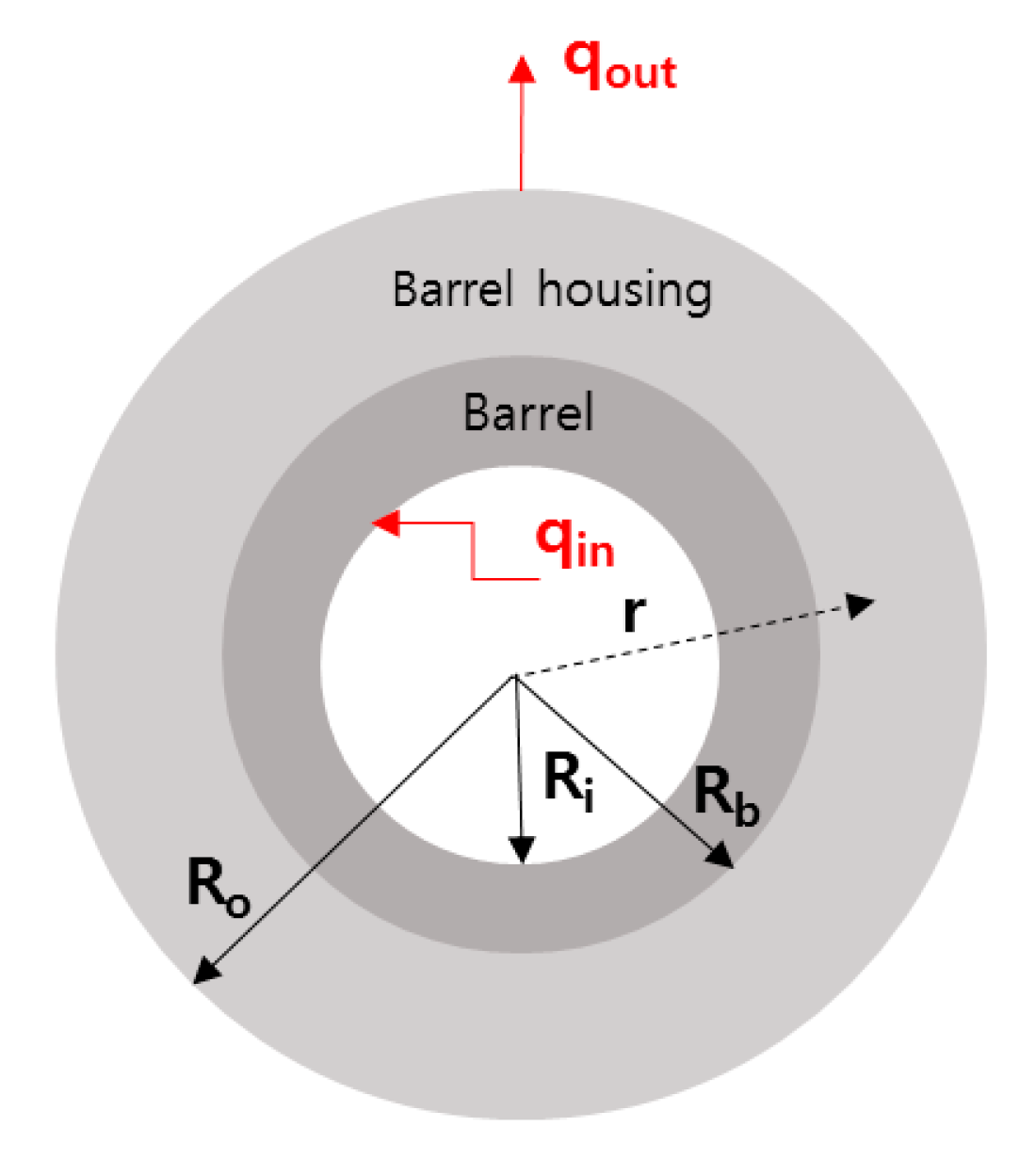
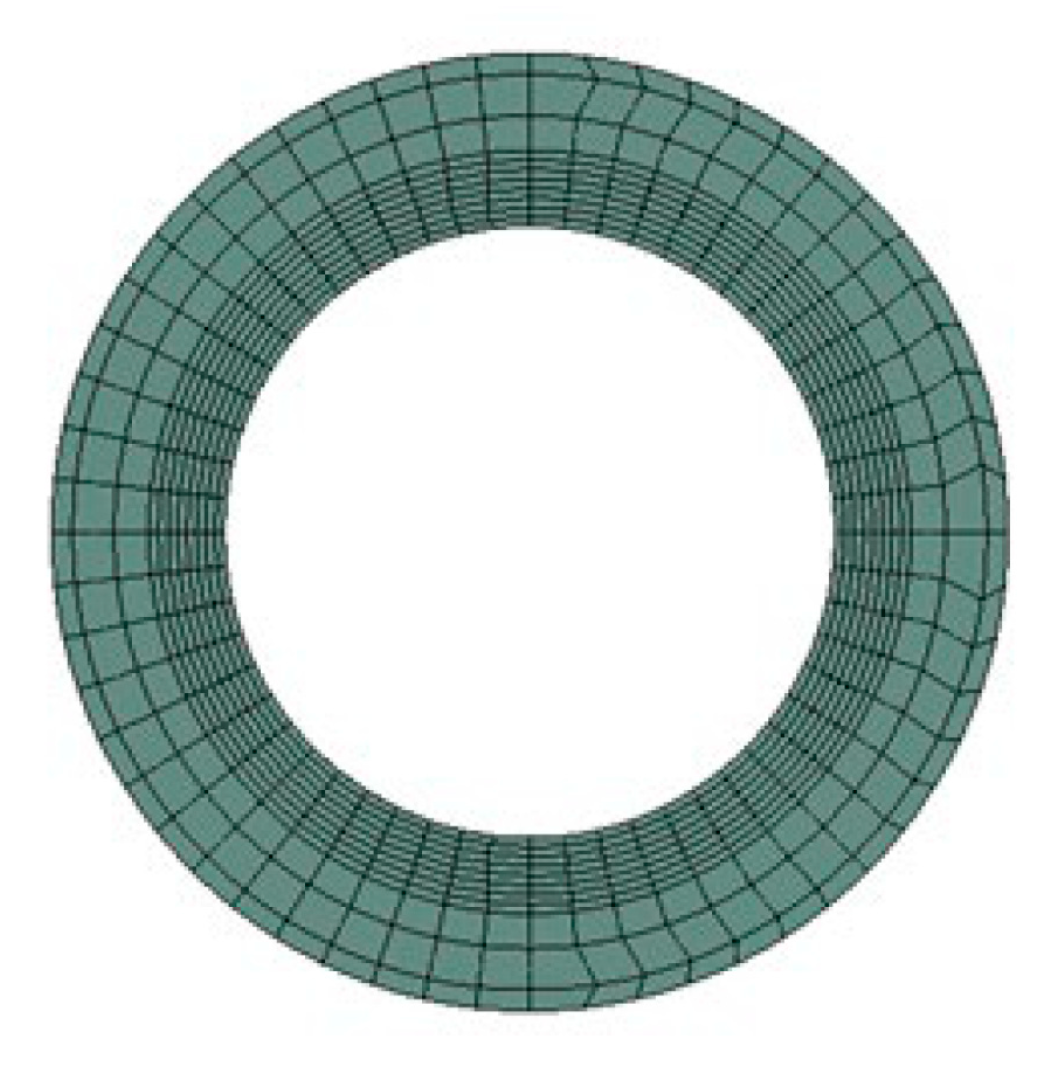
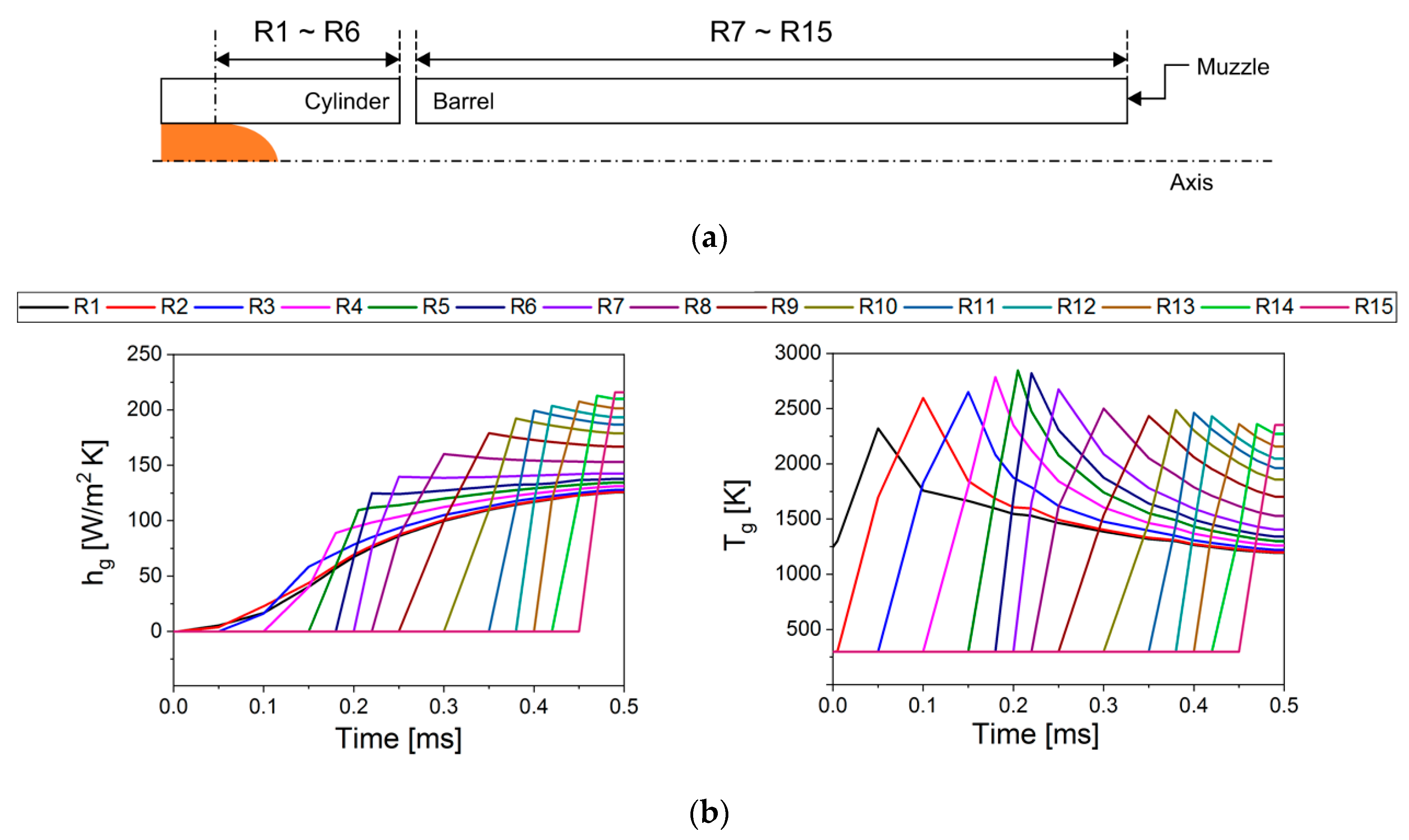


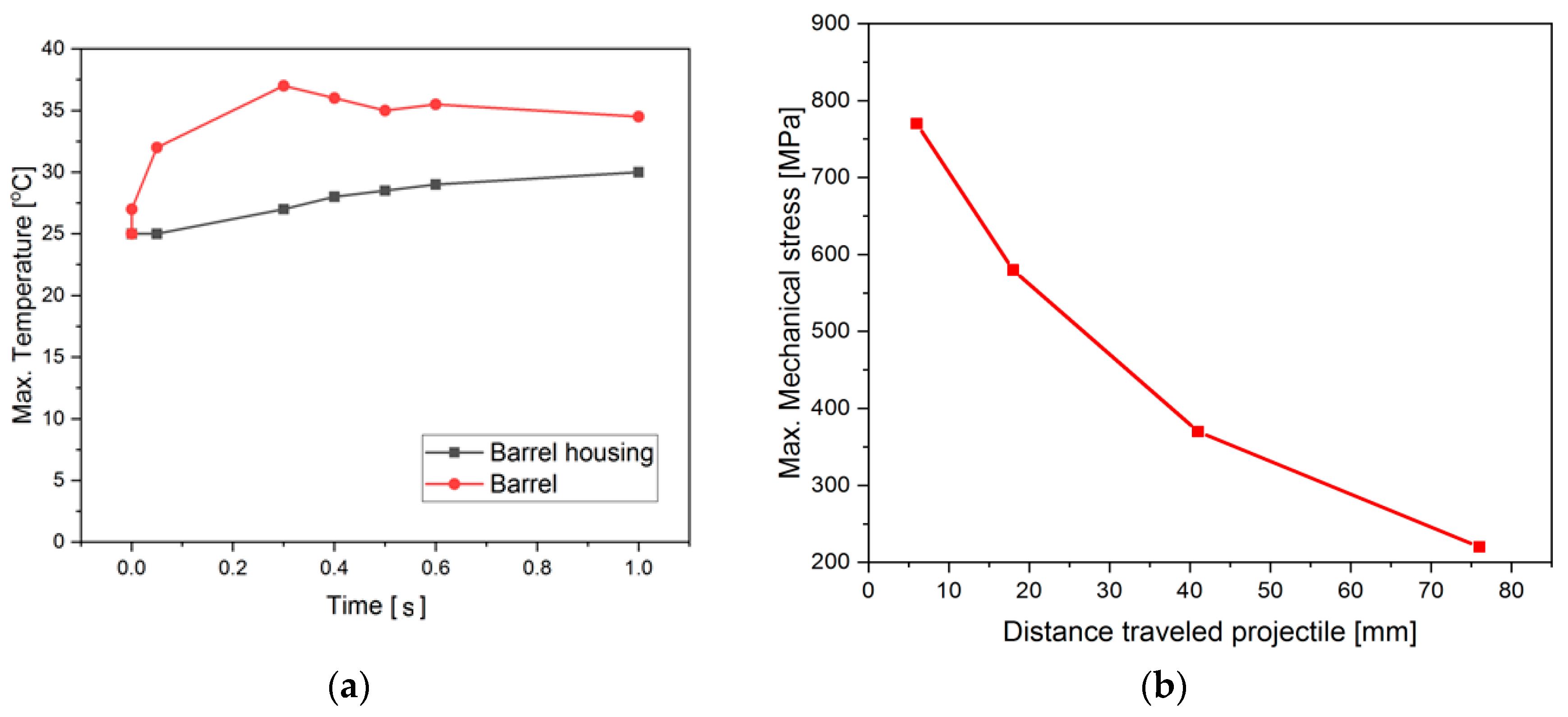

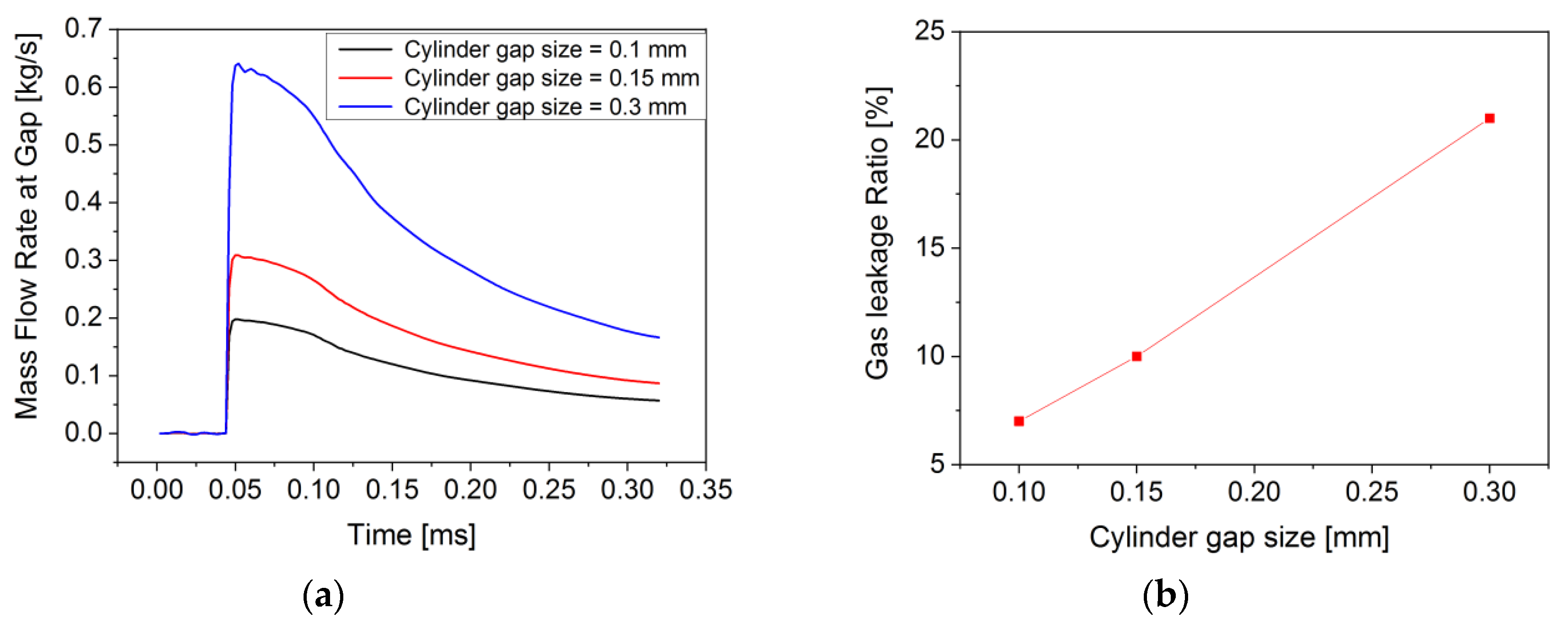
| Kf | D | Pr | Ke | γ |
|---|---|---|---|---|
| 0.023 W/mK | 8.8 mm | 0.7 | 1.75 | 49 × 10−5 m2/s at 2.800 K |
| Distance Traveled by Projectile from Barrel Entrance [mm] | Time [ms] | Pressure [MPa] |
|---|---|---|
| 6 | 0.25 | 137 |
| 18 | 0.3 | 100 |
| 41 | 0.48 | 63 |
| 76 | 0.5 | 40 |
| Parts | E [GPa] | ν | αT [/K] | ρ [kg/m3] | Specific Heat, c [J/kg·K] | k [W/m·K] |
|---|---|---|---|---|---|---|
| Barrel | 210 | 0.3 | 1.2 × 10−5 | 7850 | 434 | 60.5 |
| Barrel housing | 71 | 0.3 | 2.3 × 10−5 | 2770 | 875 | 170 |
| Type | Dynamic Mesh Zone | Six DOF Options |
|---|---|---|
| Rigid body | Projectile | On |
| Moving Fluid Region | On | |
| Stationary body | Breech, Outlet_a | - |
| Name | Mw [g/mol] | Description |
|---|---|---|
| Fluid_1 | 26.33 | Before combustion, propellant Mw |
| Fluid_2 | 33.38 | After combustion, Mw of the major components of the propellant |
| Fluid_3 | 39.5 | 1.5 times Mw of Fluid_1 |
| Name | Velocity at the Muzzle [m/s] | Travel Time [ms] |
|---|---|---|
| Ballistic Data | 347 | 0.31 |
| Fluid_1 | 335 | 0.318 |
| Fluid_2 | 341 | 0.316 |
| Fluid_3 | 345 | 0.314 |
| ρ | Mw [g/mol] | cp [J/gK] | k [W/mK] | Molecular Viscosity [kg/m·s] |
|---|---|---|---|---|
| Equation (18) | 39.5 | 1870 | 0.0242 | 1.7894 × 10−5 |
| Cylinder Gap Size [mm] | Velocity [m/s] | Time [ms] |
|---|---|---|
| 0.1 | 348 | 0.312 |
| 0.15 | 345 | 0.314 |
| 0.3 | 337 | 0.318 |
© 2020 by the authors. Licensee MDPI, Basel, Switzerland. This article is an open access article distributed under the terms and conditions of the Creative Commons Attribution (CC BY) license (http://creativecommons.org/licenses/by/4.0/).
Share and Cite
Yoon, J.; Park, J.; Park, J. Numerical Simulation and Design of a High-Temperature, High-Pressure Fluid Transport Pipe. Appl. Sci. 2020, 10, 5890. https://doi.org/10.3390/app10175890
Yoon J, Park J, Park J. Numerical Simulation and Design of a High-Temperature, High-Pressure Fluid Transport Pipe. Applied Sciences. 2020; 10(17):5890. https://doi.org/10.3390/app10175890
Chicago/Turabian StyleYoon, Jiyoung, Junkyu Park, and Jinhyoung Park. 2020. "Numerical Simulation and Design of a High-Temperature, High-Pressure Fluid Transport Pipe" Applied Sciences 10, no. 17: 5890. https://doi.org/10.3390/app10175890





